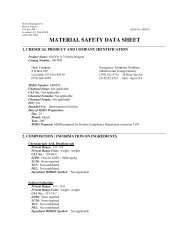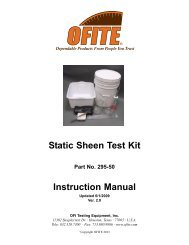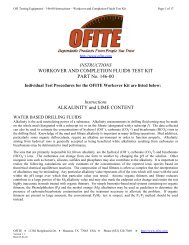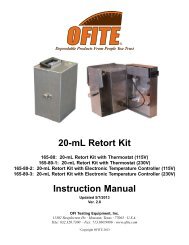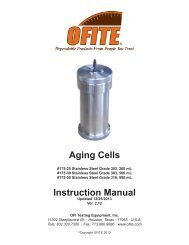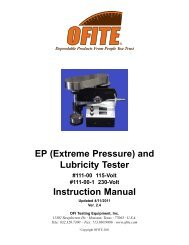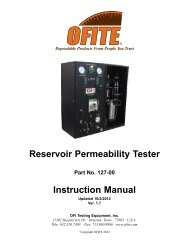Aniline Point Determination Kit - OFI Testing Equipment, Inc.
Aniline Point Determination Kit - OFI Testing Equipment, Inc.
Aniline Point Determination Kit - OFI Testing Equipment, Inc.
Create successful ePaper yourself
Turn your PDF publications into a flip-book with our unique Google optimized e-Paper software.
<strong>OFI</strong> <strong>Testing</strong> <strong>Equipment</strong>, <strong>Inc</strong>.<br />
11302 Steeplecrest Dr. Houston, Texas 77065 U.S.A.<br />
Tele: 832.320.7300 Fax: 713.880.9886<br />
www.ofite.com<br />
©<br />
Copyright <strong>OFI</strong>TE 2011<br />
<strong>Aniline</strong> <strong>Point</strong><br />
<strong>Determination</strong> <strong>Kit</strong><br />
No. 145-80 - 115 Volt<br />
No. 145-80-1 - 230 Volt<br />
Instruction Manual<br />
Updated 6/2/2009<br />
Ver. 1.3
Intro<br />
The <strong>OFI</strong>TE <strong>Aniline</strong> <strong>Point</strong> <strong>Determination</strong> <strong>Kit</strong> determines the aniline point<br />
of oil used in drilling fluid. The aniline point indicates whether damage<br />
may occur to elastomeric (rubber) parts of a drilling rig when oil is added<br />
to the drilling fluid. In general oils with a high aromatic content are more<br />
detrimental to rubber products than those with a low aromatic content.<br />
The relative aromatic content of an oil is indicated by its aniline point and<br />
oils with a high aromatic content have a low aniline point and vice versa.<br />
The higher the aniline point of the oil, the more desirable it is for drilling<br />
fluid usage. By definition, the <strong>Aniline</strong> <strong>Point</strong> is the lowest temperature at<br />
which equal volumes of <strong>Aniline</strong> and oil are completely miscible (clear).<br />
The aniline point of an oil should be 150°F or above to minimize damage<br />
to elastomer parts, but this may indicate oils of less solvency and<br />
lowered ability to disperse asphaltic materials in oil muds.<br />
This method is suitable for transparent liquid samples having an initial<br />
boiling point above room temperature and where the <strong>Aniline</strong> point is<br />
below the bubble point and above the solidification point of the <strong>Aniline</strong><br />
sample mixture. The procedure is useful in characterizing pure hydrocarbons.<br />
For example, aromatic hydrocarbons exhibit the lowest <strong>Aniline</strong><br />
points and paraffinic hydrocarbons exhibit the highest values.<br />
Cycloparafins and olefins exhibit values that lie between those of paraffins<br />
and aromatics. In a homologous series, the <strong>Aniline</strong> <strong>Point</strong> increases<br />
with increasing molecular weight. The <strong>Aniline</strong> <strong>Point</strong> for mixtures of<br />
hydrocarbons such as diesel oils and mineral oils serves as a guideline<br />
for judging the aromatic hydrocarbon content of an oil and for comparing<br />
oils.<br />
Components:<br />
#130-78-25 Heater Bath Oil, 16 fl oz<br />
#145-83 Utility Clamp, Fiberglass Jaws<br />
#152-48 Hot Plate - Stirrer, 115 Volts - or -<br />
#152-49 Hot Plate - Stirrer, 230 Volts<br />
#152-48-1 Support Rod for Stirrer, ½"<br />
#153-15-1 Test Tube, Glass, 20 × 1.2 × 150 mm<br />
#153-15-2 Test Tube, Glass, 41 × 2.0 × 150 mm<br />
#153-29-2 Syringe, Glass Tip, 10 cc<br />
#153-40 Pipette, Glass, 10 mL × 1 ⁄10 mL<br />
#153-41 Pipette Aid, Safety Bulb<br />
#153-51-3 Beaker, Glass, 50 mL<br />
#153-53-11 Stirring Bar, Magnetic, 1 ⁄2" × 5 ⁄16"<br />
#153-88 Cork for Thermometer, Size 8<br />
#153-89 Cork for Test Tube, Size 20<br />
#154-26 Thermometer, 77 to 221°F<br />
#165-62 Syringe Filter, Puradisc, PTFE<br />
Reagents:<br />
#145-84 *<strong>Aniline</strong> Solution, 8 oz (UN1547)<br />
(<strong>Aniline</strong> is an Extremely Hazardous Reagent)<br />
#285-06 Calcium Sulfate, Anhydrous, 2 oz<br />
Optional (Not <strong>Inc</strong>luded):<br />
#166-03 Portable Balance, 0 to 320 × 0.1 gram<br />
Carrying Case<br />
Parts<br />
!<br />
Important<br />
2 3
Safety<br />
!<br />
Important<br />
<strong>Aniline</strong> is highly POISONOUS and extremely HAZARDOUS. Refer to<br />
Material Safety Data Sheet (MSDS) before use. Avoid contact with<br />
skin and clothing and avoid breathing the vapor. Wear impervious protective<br />
clothing, including boots, gloves, lab coat, apron or coveralls, as<br />
appropriate, to prevent skin contact. Neoprene and nitrile rubber are<br />
recommended. Use chemical safety goggles and/or a full face shield<br />
where splashing is possible.<br />
Introduction....................................................................................................2<br />
Parts...................................................................................................................3<br />
Safety.................................................................................................................4<br />
First Aid............................................................................................................4<br />
Table of<br />
Contents<br />
First Aid<br />
In all cases, GET MEDICAL ATTENTION IMMEDIATELY.<br />
Procedure........................................................................................................5<br />
If Inhaled - Remove to fresh air. If not breathing, give artificial respiration.<br />
If breathing is difficult, give oxygen. Do not give mouth to mouth<br />
resuscitation.<br />
If Skin Contact - Immediately flush skin with plenty of water for at<br />
least 15 minutes while removing contaminated clothing and shoes.<br />
Wash clothing before reuse. Thoroughly clean shoes before reuse.<br />
If Taken Internally - Induce vomiting immediately as directed by medical<br />
personnel. Never give anything by mouth to an unconscious person.<br />
If Eye Contact - Immediately flush eyes with plenty of water for at<br />
least 15 minutes, lifting upper and lower eyelids occasionally.<br />
Procedure<br />
1. Withdraw 15 mL of oil sample using a clean, dry 10 mL glass<br />
syringe. Inject 15 mL of oil sample into a 50 mL glass beaker.<br />
Insert magnetic stir bar and place onto the magnetic stirrer. Turn<br />
on magnetic stirrer and allow a vortex to be formed. Clean and<br />
dry glass syringe after use.<br />
2. Dry the oil sample by adding approximately 10% by volume<br />
Calcium Sulfate as a drying agent in the oil sample. Allow the oil<br />
sample to stir for 5 minutes.<br />
3. Screw in the support rod on the back of the heated magnetic stirrer<br />
and attach utility clamp. Add heating bath oil into the jacket<br />
tube until it’s approximately half full. Place the jacket tube into the<br />
utility clamp and lower both until the bottom of the jacket tube<br />
comes in contact with the top of the heated magnetic stirrer.<br />
4. Use the 10 mL glass syringe and withdraw 10 mL of oil sample.<br />
Attach a PTFE membrane filter onto the Luer Lok fitting of the 10<br />
mL glass syringe.<br />
4<br />
5. Insert the magnetic stir bar and inject 10 mL of filtered oil sample<br />
into the test tube.<br />
1
6. Using a rapid release pipetting device, or suction bulb and glass<br />
pipette, withdraw 10 mL of <strong>Aniline</strong> and inject it into the test tube.<br />
Place the cork with small hole bored out onto the test tube. Do<br />
not use a rubber stopper.<br />
7. Insert the thermometer through the hole in the stopper, making<br />
sure the thermometer does not touch the sides or the bottom of<br />
the test tube.<br />
8. While at room temperature, turn on magnetic stirrer and allow the<br />
magnetic stir bar to stir the mixture rapidly. Avoid forming air bubbles.<br />
Observe if the mixture is miscible (clear) or immiscible<br />
(cloudy). If it is clear, at ambient temperature, the mixture must be<br />
cooled in a cooling bath. Allow the mixture to cool slowly while<br />
stirring rapidly and determine the <strong>Aniline</strong> point as described below<br />
in step 10.<br />
For most base oils the <strong>Aniline</strong>-oil mixture will be immiscible<br />
(cloudy) at room temperature.<br />
Note<br />
9. If the mixture at ambient temperature is cloudy, heat the mixture<br />
slowly to increase the temperature of the mixture in the test tube<br />
at a rate of 2 to 5°F per minute (1 to 3°C/min.). Stir the mixture<br />
until both liquids completely mix and become clear. Remove the<br />
mixture from the heating source.<br />
Water should not be used as a heating or cooling medium<br />
because <strong>Aniline</strong> is hygroscopic. Moist <strong>Aniline</strong> will cause erroneously<br />
high results.<br />
Do not heat an <strong>Aniline</strong>-oil mixture beyond 200°F (93°C). To do so<br />
could be unsafe.<br />
10. Continue stirring the mixture as it cools at a rate of 1 to 1.8°F per<br />
minute (0.5 to 1.0°C/min).<br />
Note<br />
!<br />
Important<br />
Monitor the mixture as it cools and notice when the cloudiness first<br />
reappears. Record as the "<strong>Aniline</strong> <strong>Point</strong>" the temperature at which<br />
the mixture becomes cloudy throughout. The true <strong>Aniline</strong> <strong>Point</strong> is<br />
characterized by a turbidity that is so cloudy that it obscures the<br />
thermometer bulb in reflected light.<br />
11. Continue cooling the mixture while stirring to a temperature of 2.0<br />
to 3.5°F (1 to 2°C) below the first appearance of cloudiness.<br />
12. Heat the mixture again until it again becomes clear. Remove the<br />
heat and cool until the cloudiness returns to obtain another observation<br />
of the <strong>Aniline</strong> <strong>Point</strong> Temperature.<br />
13. Repeat the observations of the <strong>Aniline</strong> <strong>Point</strong> several times until a<br />
value is determined to within 1°F (0.5°C).<br />
5



